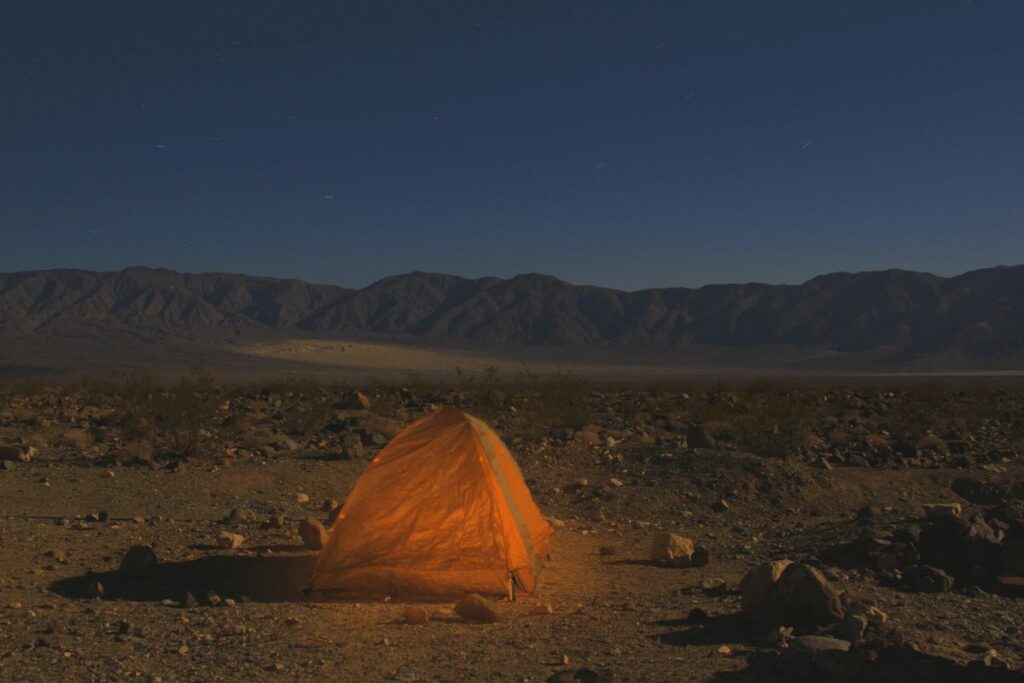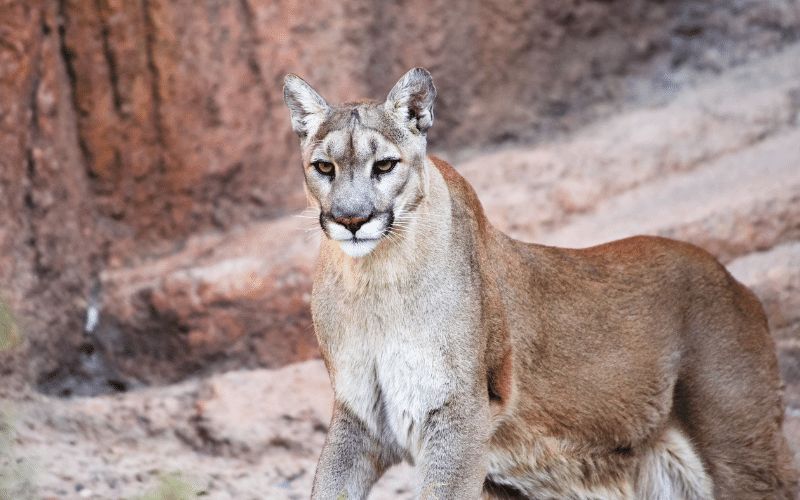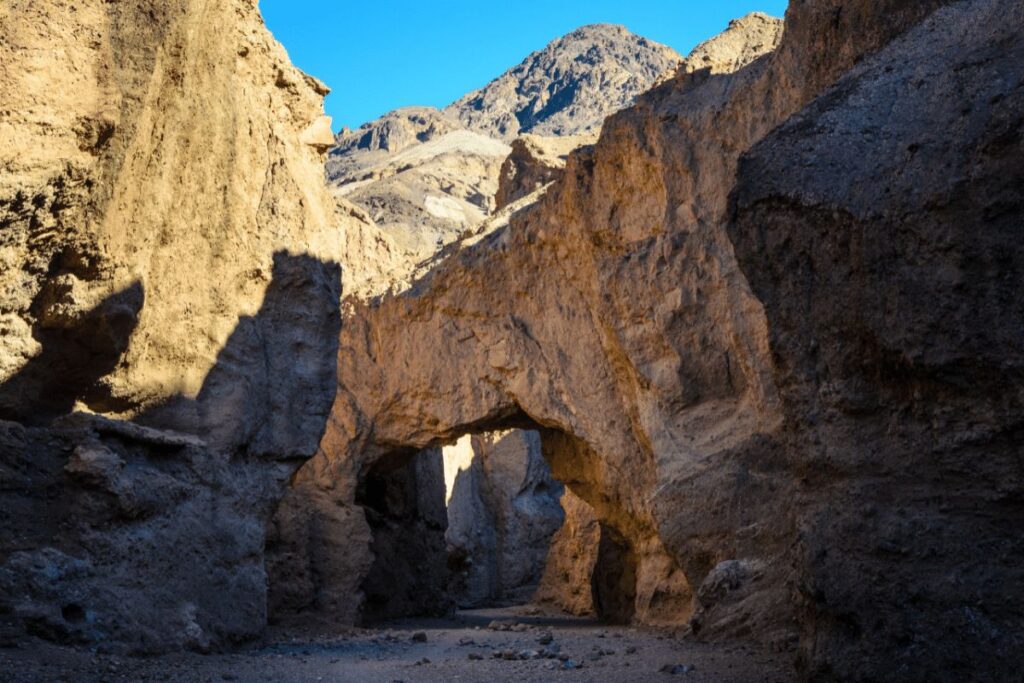Discover the ultimate guide to camping in Death Valley! Explore the best campsites, rules, and activities for a thrilling desert adventure
Dreaming of a starlit escape amidst dramatic desert landscapes? Camping in Death Valley National Park promises just that – and so much more!
This vast wonderland, nestled in the heart of the Mojave Desert, beckons adventurers like you to embrace its wild embrace.
Our guide delves deep into the heart of camping in Death Valley, guiding you through its unique campgrounds, from the popular Furnace Creek to the hidden gems like Eureka Dunes.
And it’s not just about where to pitch your tent! We’ll take you through the maze of camping rules, seasonal tips, and even introduce you to the secretive wildlife residents of the desert.
Curious about scaling sand dunes or navigating salt flats? We’ve cataloged the unmissable activities to enrich your camping adventure.
So, dust off your camping gear and get ready for a rendezvous with the raw beauty of Death Valley!
Developed Campgrounds
These campgrounds typically have facilities and amenities that make camping more convenient and comfortable for visitors, including:
- Designated campsites with amenities such as picnic tables, fire pits, and access to drinking water
- Restrooms with running water and toilets
- Showers
- Trash and recycling facilities
- Campground hosts or rangers to provide information and assistance to visitors
- Access to recreational activities such as hiking trails, fishing, or boating
Furnace Creek Campground
Located near the Furnace Creek Visitor Center, this NPS campground is the only one in the park that accepts reservations and offers sites with full hookups for RVs, as well as dry sites for tents. With 136 sites to choose from, there’s something for everyone at Furnace Creek Campground.
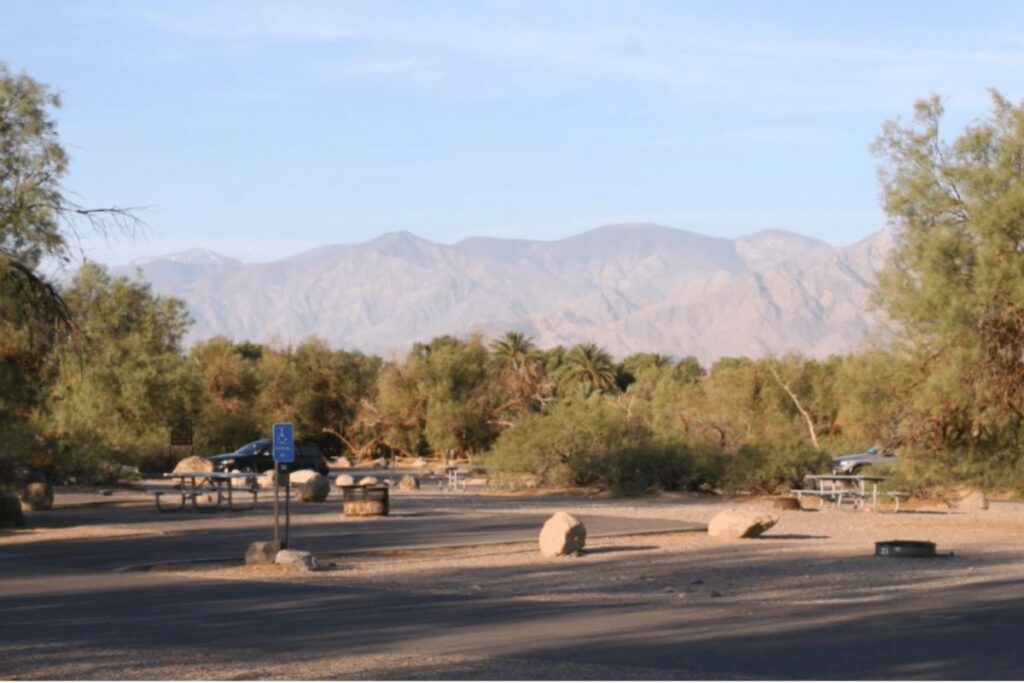
Reservations can be made up to six months in advance for camping dates between 10/15 and 4/15, and during the remainder of the year, the campground operates on a first-come, first-serve basis. Due to its popularity, it’s strongly recommended to book your reservation as soon as possible.
The campground features 18 sites with electric hookups, 45 tent-only sites, 35 walk-to/boat-to sites, and five group sites that can accommodate between nine and 40 people. The campsite allows no more than eight people and two vehicles or one recreational vehicle per site, and larger groups can reserve group sites at the Furnace Creek Campground.
While staying at the campground, you’ll have access to a range of amenities, including cell phone reception (year-round), trash and recycling collection (year-round), and a camp store (year-round) that sells snacks, drinks, and camping gear. Unfortunately, there is no internet connectivity or food storage lockers, so be sure to plan accordingly.
While you’re at the campground, you can enjoy a range of outdoor activities, including hiking, stargazing, and photography. The campground is situated in a stunning location with breathtaking views of the surrounding mountains and desert landscape. It’s also a great base camp for exploring the park’s other natural wonders, including Badwater Basin, Zabriskie Point, and Dante’s View.
If you plan to cook your own meals, it’s worth noting that fires must be in an NPS-provided grate, and barbeque grills are prohibited. Gas-burning stoves are allowed, and flush toilets are available year-round. However, there are no showers at the campground.
While summer temperatures can soar to well above 100°F, November through March offers more pleasant temperatures. Keep in mind that Furnace Creek Campground is located below sea level, so be sure to stay hydrated and protect yourself from the sun during the warmer months.
The cost for a standard campsite is $22.00, and for a full hook-up site, the fee is $36.00 (with a half-price discount for Lifetime Pass holders) plus a $14.00 utility fee (not discounted). Group sites are also available for $35.00 for sites #3, #4, and #5, and $60.00 for sites #1 and #2.
Furnace Creek Campground is a fantastic option for those looking for a unique camping experience in Death Valley National Park. With its beautiful location, range of camping options, and convenient amenities, you’re sure to have an unforgettable adventure at this stunning campground.
Texas Springs Campground
Nestled in the hills above Furnace Creek, this campground offers breathtaking views and some trees to provide some shade.
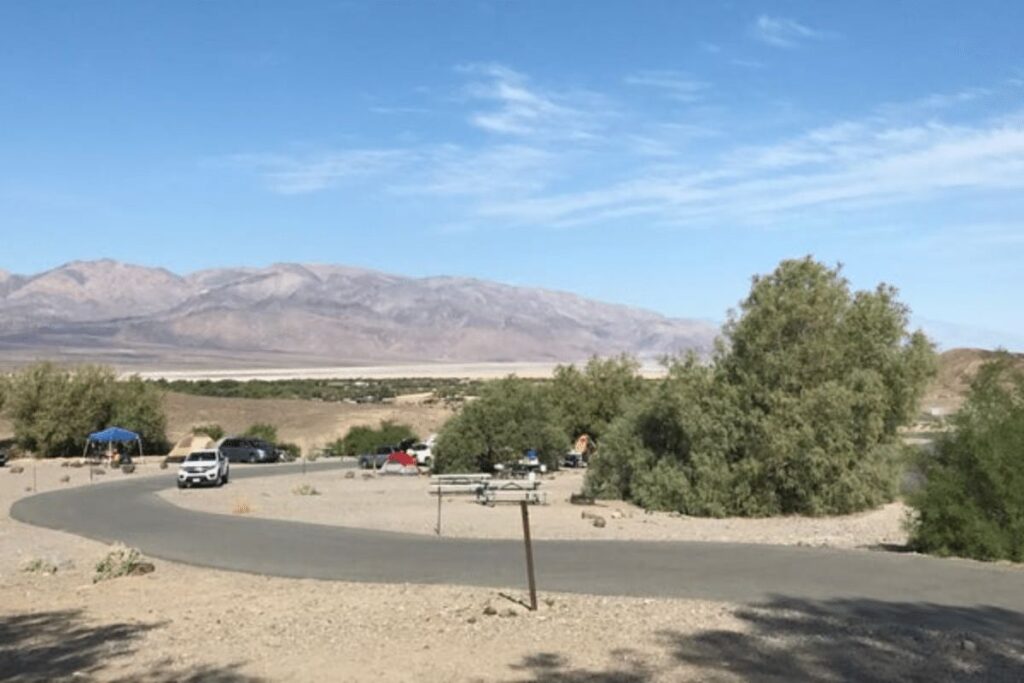
If you’re looking for a true camping experience, the Texas Springs Campground is perfect for you! No generators are allowed, but each site comes with a firegrate and picnic table so you can still cook up some tasty meals and enjoy the beautiful outdoors. The fee for your stay is paid at the pay station at the front of the campground, and it’s only $16 per night!
While services such as showers, laundry, firewood, ice, and internet can be purchased nearby at Furnace Creek Ranch, keep in mind that cell phone service is very limited, and not all carriers offer reception. Internet is usually available for a fee at the general store less than 1 mile away.
Make sure to follow all the regulations when camping at the Texas Springs Campground, including quiet hours from 10 PM to 7 AM and no wood gathering. You can only have 1 recreational vehicle with tow, 2 cars, or 4 motorcycles per site, and there is a limit of 8 people per site with a stay limit of 30 days. No holding or reserving sites.
Pets are welcome but must be confined or on a leash no longer than 6 feet, and owners are responsible for cleanup. Unattended food, garbage or cooking equipment must be sealed in a vehicle or a solid, non-pliable, animal-resistant container.
So, what are you waiting for? Grab your camping gear and head on over to the Texas Springs Campground for an unforgettable camping experience!
Sunset Campground
This picturesque campground is located in the heart of Death Valley and is open seasonally from October 24th at noon. With 230 sites available on a first come, first served basis, there’s plenty of room for everyone. And don’t worry, despite the arid desert environment, the campground is spacious and rarely fills up.
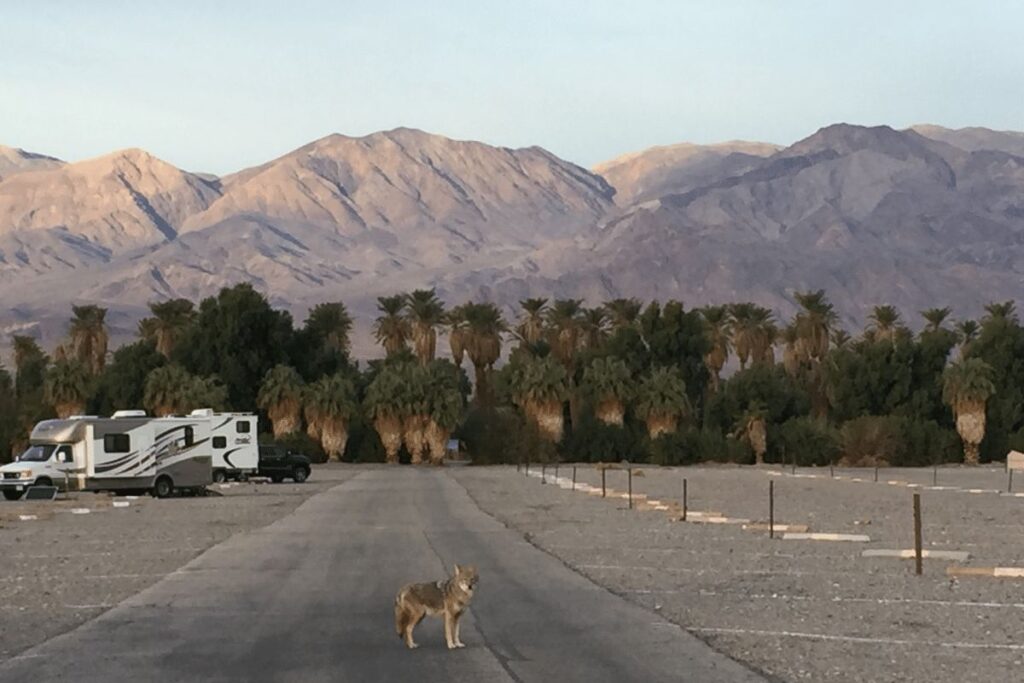
While vegetation may be sparse, the Sunset Campground is a perfect spot for car and tent camping. It’s important to note that individual sites do not come with fire grates or picnic tables, but don’t let that deter you. There are a few designated public areas within the campground where campfires are allowed. Just remember to check the fire and stove policy beforehand.
The campground fee of $14 is paid at the pay station onsite, so you can get settled in quickly. The Sunset Campground offers no electric hookups or amenities like showers, but it’s perfect for those looking to disconnect and enjoy nature. There’s even a nearby camp store to purchase supplies like firewood, ice, and groceries.
Cell phone reception is available year-round, but internet connectivity is not. Trash and recycling collection are available seasonally, so please plan accordingly. It’s also important to remember that food storage lockers are not available.
But wait, there’s more! If you’re traveling with a furry friend, they’re welcome at Sunset Campground, but please keep them on a leash no longer than 6 feet. And don’t forget to clean up after them!
The Sunset Campground is a special place and the National Park Service has implemented several regulations to ensure everyone can enjoy it. Generator hours are limited from 7 AM to 9 PM, and quiet hours are enforced from 10 PM to 7 AM. Additionally, camping limits are in place to ensure all visitors have enough space to enjoy their stay.
The Sunset Campground is a perfect spot for those looking for a rugged, back-to-nature experience. It’s not for those looking for luxury amenities or high-tech connectivity, but for those who truly want to disconnect and enjoy the beauty of Death Valley National Park, it’s an excellent choice.
Stovepipe Wells Campground
This first-come, first-served campground is open seasonally starting October 15th at noon, offering 190 sites for campers to choose from. With stunning views of Death Valley proper and the Mesquite Flat Sand Dunes, it’s no wonder why Stovepipe Wells is a popular choice for outdoor enthusiasts.
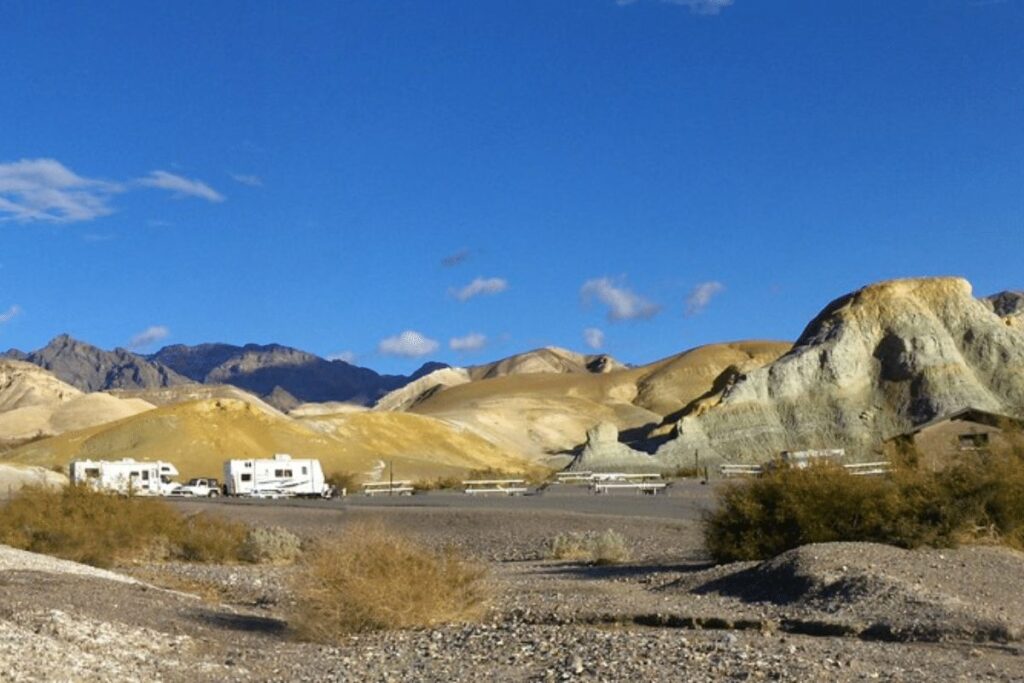
While the campground does not offer electric hookups or RV-only sites, it does have 28 tent-only sites with firegrates for those who want to cook over an open flame. Gas-burning stoves are also permitted for cooking, but charcoal grills are prohibited. Fires are only allowed in NPS-provided rings and must be attended to at all times.
Looking to stay connected during your camping trip? Stovepipe Wells Campground offers cell phone reception year-round, but internet connectivity is not available. However, supplies and services such as firewood, ice, showers, and internet access can be purchased at the nearby privately operated Stovepipe Wells Resort.
For those in need of restroom facilities, flush toilets are available seasonally. The campground does not have shower facilities, but with the stunning natural beauty of Death Valley surrounding you, who needs a shower, anyway?
It’s important to note that generators are only permitted during designated hours (7 AM to 7 PM), and quiet hours are enforced from 10 PM to 7 AM. Camping limits are in place to ensure the safety and comfort of all visitors, including a limit of one recreational vehicle with tow, two cars, or four motorcycles per site, and a maximum of eight people per site. Additionally, stay is limited to 30 days, and sites cannot be held or reserved.
At Stovepipe Wells Campground, the National Park Service asks that visitors respect the wildlife and environment. Pets must be confined or on a leash no longer than 6 feet and are only allowed along roads, in the campground, and in developed areas.
Owners are responsible for cleaning up after their pets, and food, garbage, and cooking equipment must be sealed in a vehicle or a solid container to prevent attracting wildlife.
So what are you waiting for? Book your camping trip at Stovepipe Wells Campground today and experience the stunning natural beauty of Death Valley for yourself!
Emigrant Campground
If you’re looking for a secluded camping experience in the heart of Death Valley, look no further than Emigrant Campground. Located at an elevation of 2100 feet and overlooking the stunning Cottonwood Mountains, this campground offers an unbeatable combination of natural beauty and tranquility. There is no cost to camp here. Please pay your park entry fee.
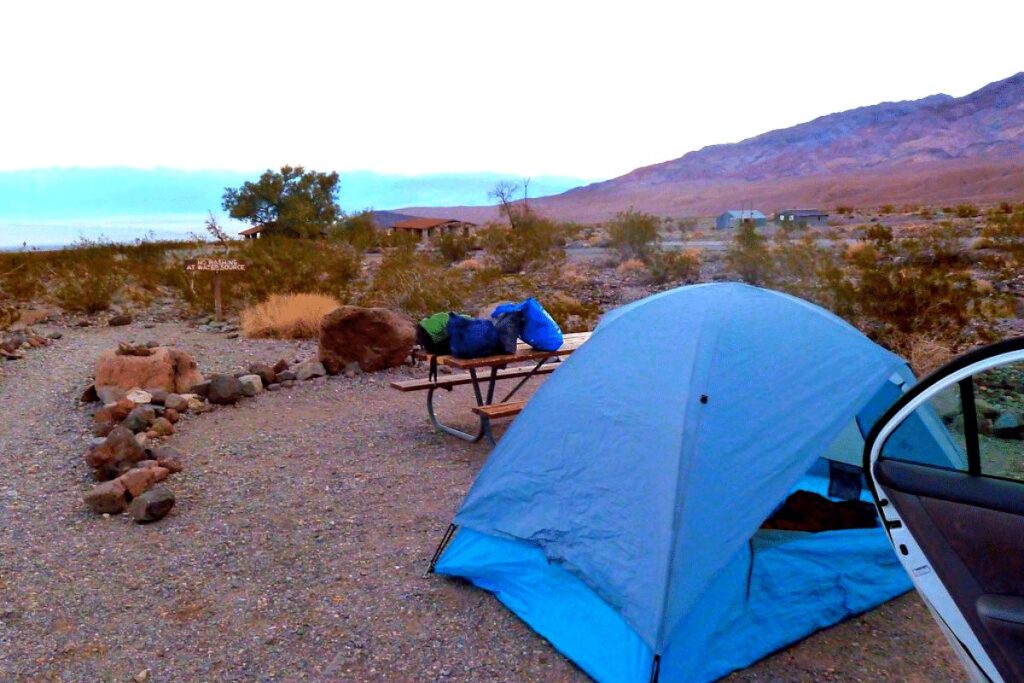
Emigrant Campground is a small, first-come-first-served tent-only campground with 10 sites. There’s no need to worry about any additional fees – camping here is completely free, although you will need to pay the park entry fee. But don’t let the lack of amenities fool you – Emigrant Campground offers everything you need for a comfortable stay.
Each site is equipped with a fire pit and a picnic table, perfect for cooking up a delicious meal under the stars. While campfires and charcoal grills are prohibited, gas burning stoves are allowed. And when nature calls, you can make use of the flush toilets that are available year-round.
Perhaps the best thing about Emigrant Campground is the sense of peace and tranquility you’ll experience. With no cell phone reception or internet connectivity, you’ll be able to disconnect from the stresses of modern life and immerse yourself in the natural beauty of Death Valley.
Of course, as with any national park, there are regulations that must be followed. Pets must be confined or on a leash no longer than 6 feet, and owners are responsible for cleaning up after them. All unattended food, garbage, or cooking equipment must be stored in an animal-resistant container or a vehicle. And, perhaps most importantly, please do not feed or disturb the wildlife.
Emigrant Campground is truly a hidden gem in Death Valley, offering a peaceful retreat in one of the most beautiful places on earth. So pack your tent, your hiking boots, and your sense of adventure, and get ready to experience the natural wonders of Death Valley like never before.
Wildrose Campground
Nestled at an elevation of 4100 ft / 1250 meters, this first-come, first-served campground offers 23 sites with no additional fees.
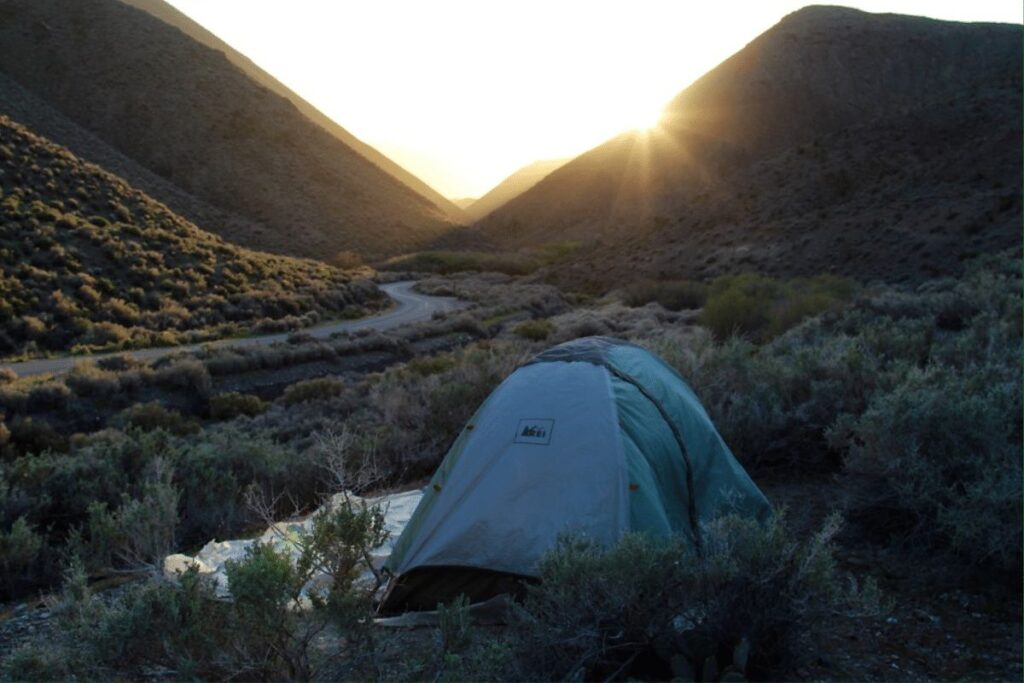
While there are no hookups available, generators are allowed from 7am to 7pm, so you can still enjoy some of the comforts of home. Just be sure to follow the regulations and never leave your generator running unattended.
The sites themselves are surrounded by mesquite bushes and rolling hills, giving you a true desert camping experience. The dirt and gravel sites are perfect for tents or RVs, but keep in mind that there are no designated tent-only sites.
If you plan to cook during your stay, gas-burning stoves are permitted, but charcoal grills are prohibited. Fires are allowed only in NPS-provided pits, so be sure to bring your own firewood or purchase it from a local vendor. However, fires are typically prohibited between June 15 and September 15 or during periods of high fire danger, so be sure to check with the park rangers before starting a fire.
Wildrose Campground also offers vault toilets year-round, but there are no showers available. Additionally, water spigots may be turned off during periods of freezing temperatures, so be sure to bring your own water or fill up before arriving.
While there are no staff members on site, there are trash and recycling collections year-round, so you can keep your campsite clean and tidy. And don’t forget about the breathtaking views! Surrounded by the stunning Panamint Mountains, Wildrose Campground offers unparalleled scenery and the opportunity to spot some of the local wildlife, like coyotes and ravens.
As with all National Park campgrounds, there are regulations in place to help protect the environment and ensure that everyone can enjoy their stay. Be sure to limit your stay to 30 days, and no more than 8 people per site. Keep your pets confined or on a leash no longer than 6 feet, and always clean up after them. And remember, never feed the wildlife!
Wildrose Campground is a great choice for those seeking a remote and rustic camping experience in one of the most beautiful areas of the country. So pack your bags, grab your tent, and get ready for an unforgettable adventure in the Panamint Mountains!
Mesquite Spring Campground
Located just 2 miles off the Scotty’s Castle Road below Grapevine Canyon, this first-come, first-served campground is a perfect base camp for your exploration of the northern parts of Death Valley National Park.
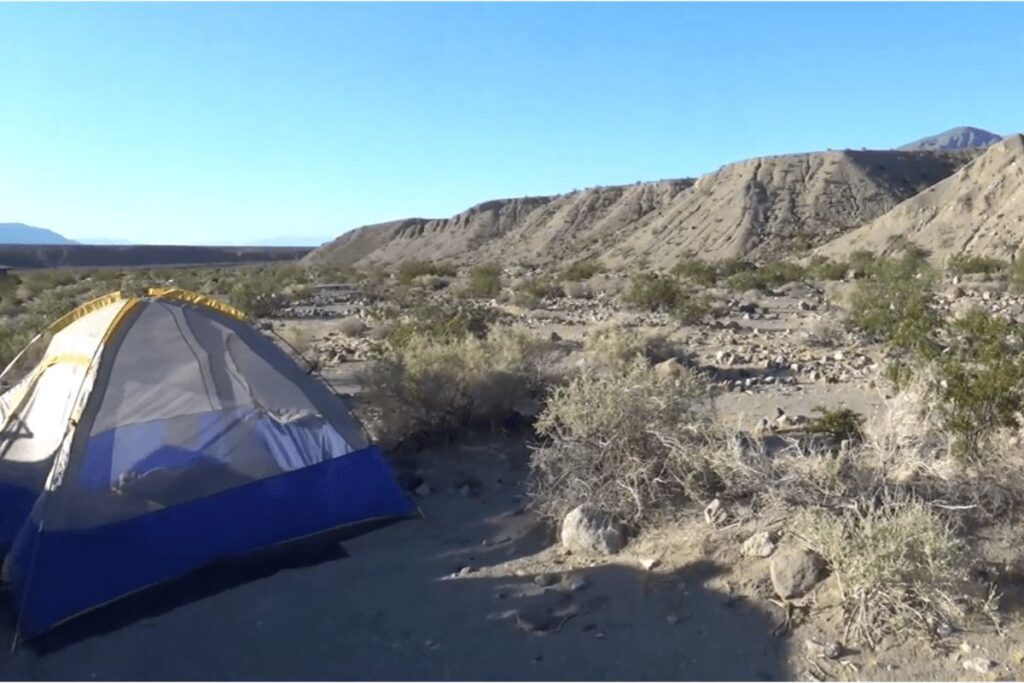
Surrounded by desert mountains and geological features, this campground offers 40 sites with fire grates and picnic tables to make your stay more comfortable. And the best part? You don’t have to worry about any hook-ups! The fee for camping is paid at the automatic pay station located at the front of the campground.
Mesquite Spring Campground is a true oasis in the middle of the desert. Each site is equipped with potable water, so you don’t have to worry about bringing any with you. And although cell phone reception and internet connectivity are not available, you can rest easy knowing that there is year-round trash and recycling collection.
There is no food storage locker or camp store, but don’t let that stop you from enjoying your stay – bring your own supplies and make memories!
Mesquite Spring Campground is perfect for those who love camping under the stars, but it’s not for those who want to stay glued to their screens. You can truly disconnect and enjoy nature in its raw form.
There are no showers or laundry facilities, but you’ll be too busy exploring to even notice. And if you happen to run out of firewood or need some ice, you’ll have to bring it with you as there are no facilities to buy any.
If you’re worried about staff on site, don’t be – there are seasonal staff members available to assist you if needed. And if you’re looking for some entertainment, you won’t find an amphitheater, but there’s plenty to do in the area. The fee for standard campsites is $14.00, and it’s worth every penny.
Remember to adhere to the campground’s regulations – fires are allowed in provided metal fire grates, but wood gathering is not permitted. Quiet hours are from 10 PM to 7 AM, and generators are only allowed to run from 7 AM to 7 PM. No holding or reserving sites, and you must check out by 12 PM Noon.
And don’t forget about the wildlife! You’ll see plenty of it, but please do not feed them. Pets must be confined or on a leash no longer than 6 feet, and you must clean up after them.
Finally, make sure to properly store your food and trash in animal-resistant containers.
So pack up your gear, and head over to Mesquite Spring Campground. Adventure awaits you in this oasis in the desert!
Primitive Campgrounds
Death Valley National Park is a haven for outdoor enthusiasts looking for adventure and an escape from the city life. The park boasts a unique landscape, from towering sand dunes to rugged mountains, and offers a variety of camping options, including primitive camping. If you are up for a more rustic camping experience, then primitive camping might just be what you need. Death Valley National Park has four primitive campgrounds, each with its own unique features and challenges.
1. Mahogany Flat Campground
Mahogany Flat Campground is the highest campground in Death Valley, located at an elevation of 8,200 feet. This primitive campground is accessible via a steep, winding, and narrow dirt road, and is only open from late spring to early fall due to snow accumulation during winter months.
The campground offers 10 campsites, each with a fire ring, picnic table, and food storage locker. There are no toilets, water, or other amenities at this campground, so be sure to bring your own supplies and pack out all trash.
2. Thorndike Campground
Thorndike Campground is located at an elevation of 7,400 feet on the western slope of the Panamint Mountains. This primitive campground is accessible via a steep, narrow dirt road that requires a high-clearance vehicle. The campground offers six campsites, each with a fire ring, picnic table, and food storage locker. There are no toilets, water, or other amenities at this campground, so be sure to bring your own supplies and pack out all trash.
3. Eureka Dunes Campground
This primitive campground offers a unique camping experience, surrounded by towering sand dunes that are the tallest in California. The campground is first-come, first-served and features six sites, each with a picnic table and fire ring. There are no amenities at this campground, so visitors must come prepared with all necessary supplies and water.
4. Homestake Dry Camp
Homestake Dry Camp is located on the eastern side of Death Valley National Park and is accessible via a graded dirt road.
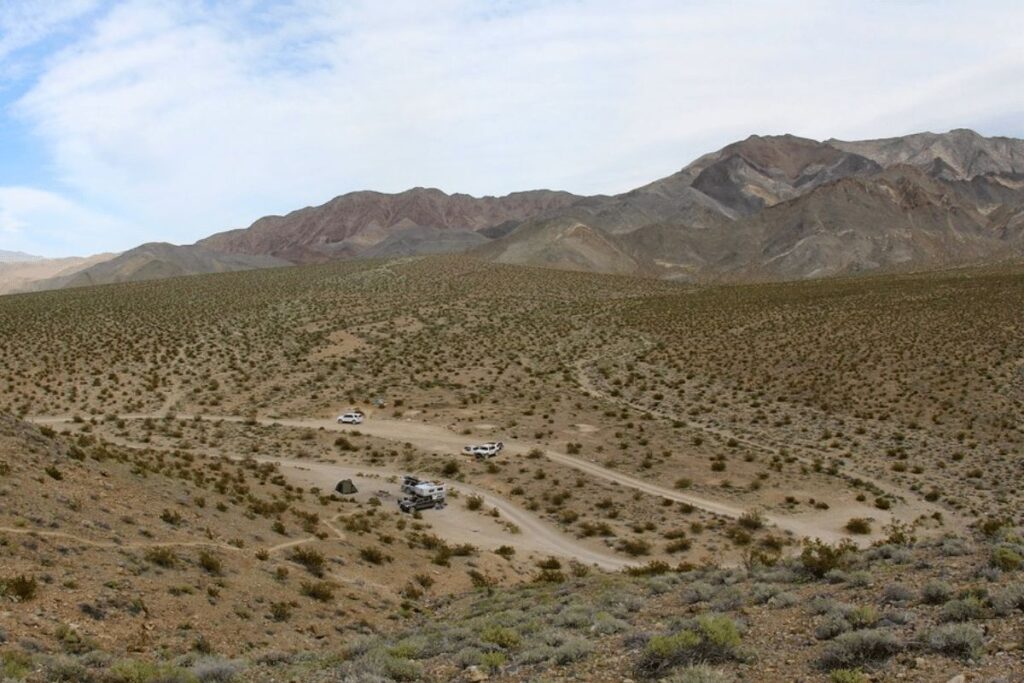
The campground offers 10 primitive campsites, each with a fire ring and picnic table, but no food storage lockers or other amenities. There are no toilets or water available at this campground, so be sure to bring your own supplies and pack out all trash.
5. Saline Valley Campground
This campground is located in a remote and rugged valley in the northern part of the park. The campground features 30 sites, each with a picnic table and fire ring, and offers a chance to soak in the nearby natural hot springs. There are no amenities at this campground, and the road to get there is rough, so high-clearance vehicles are recommended. Visitors must also come prepared with all necessary supplies and water.
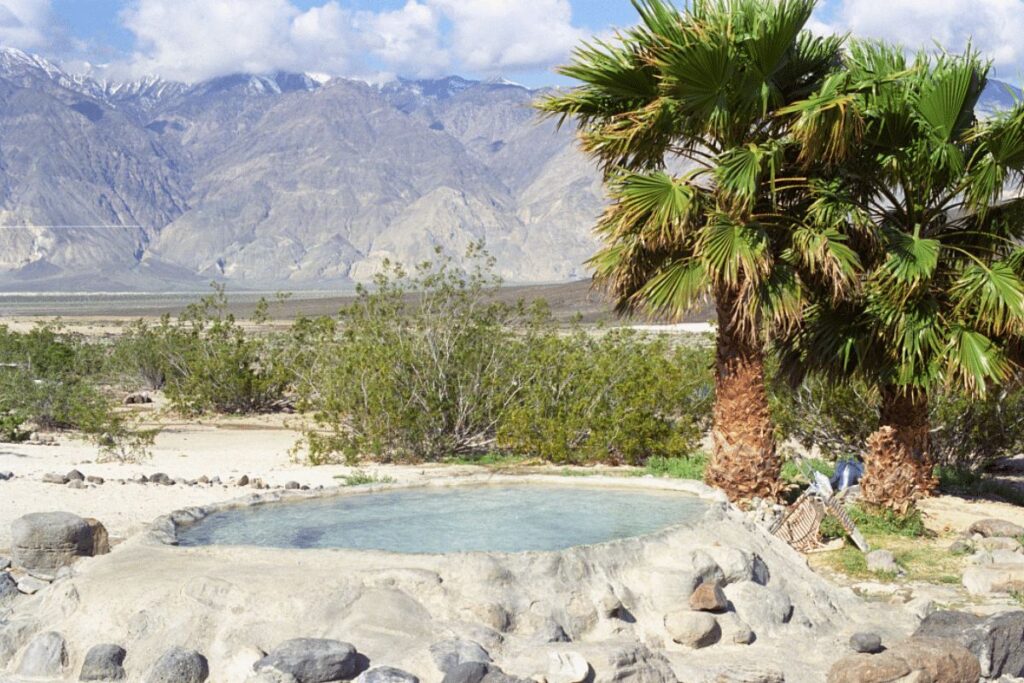
Primitive camping in Death Valley National Park offers a unique and rewarding experience, but it is not for everyone. Primitive campgrounds lack many of the amenities found at developed campgrounds, so visitors should be prepared to bring all necessary supplies, including food, water, and camping gear. Additionally, visitors should be aware of the park’s regulations and practice Leave No Trace principles to minimize their impact on the environment.
Some important regulations to keep in mind when primitive camping in Death Valley National Park include:
- Camping is permitted only in designated sites.
- Campfires are allowed only in established fire rings or grills.
- Wood gathering is prohibited, so bring your own firewood or use charcoal or a camp stove.
- All trash and waste must be packed out.
- Pets must be kept on a leash no longer than six feet and under control at all times.
Primitive camping in Death Valley National Park offers a unique and rewarding experience for those who are prepared and willing to take on the challenge. With stunning scenery and a variety of wildlife to observe, a primitive camping trip to Death Valley National Park is sure to be an unforgettable adventure.
Backcountry Camping in Death Valley – all you need to know
Looking for a rugged wilderness adventure? Death Valley National Park is one of the most spectacular places to explore the backcountry. With over 3.4 million acres of designated wilderness, the park offers vast open spaces, rugged mountain ranges, and stunning vistas.
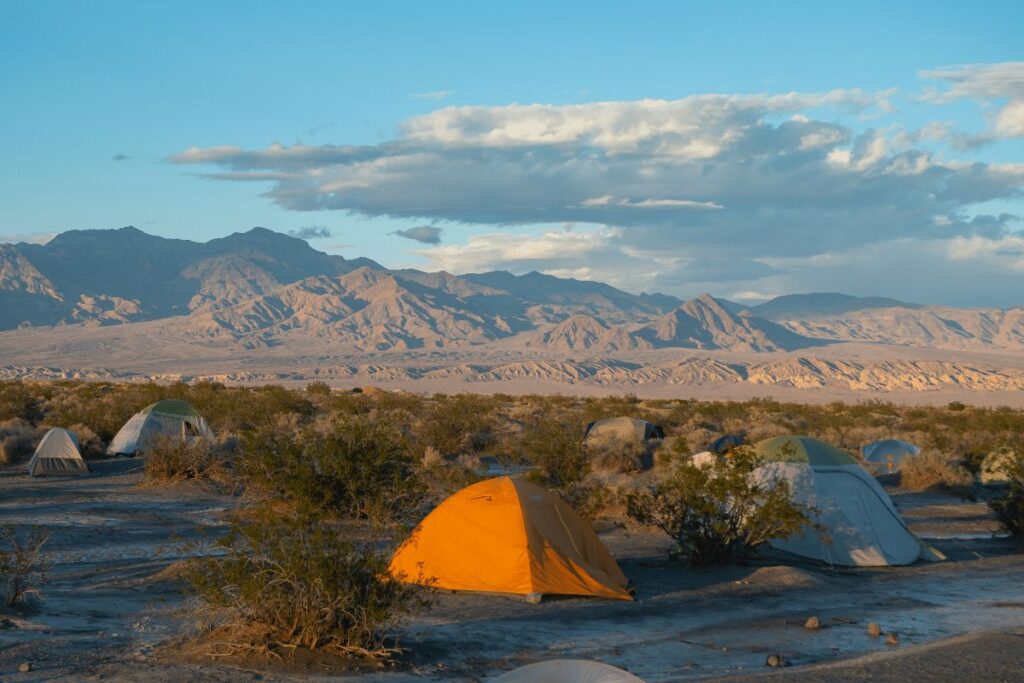
However, before you head out, there are some important rules and regulations to keep in mind. In this guide, we will give you all the necessary details for a successful backcountry camping trip in Death Valley National Park.
Regulations and Information
Free permits are required for roadside camping along Echo Canyon Road, Hole in the Wall Road, Cottonwood Canyon Road, and Marble Canyon Road. Camping in these areas is only allowed in designated sites with a free permit. Backpacking in Cottonwood Canyon – Marble Canyon Loop requires a permit, which is free but mandatory. However, permits are recommended but not required for roadside camping and backpacking in other parts of the park.
Campfires are prohibited, and fire can only be made in established campgrounds with provided metal fire rings. Gathering wood is unlawful, and burning of wood is not allowed in the backcountry.
Campstoves and propane grills are allowed in all areas. Group size is limited to 12 people and no more than 4 vehicles. Larger groups must split up and camp at least 1/2 mile apart.
Off-road driving is prohibited, as the desert environment is extremely fragile and slow to recover from vehicle damage.
If pulling off a road to camp, choose a place that has already been disturbed. Pets are permitted only in developed areas and on park roads, and they must be leashed and restrained at all times. Owners are responsible for clean-up of pet feces. Pets are not allowed off roads, on trails, or in the wilderness areas of the park.
Know where you can go! While vast areas of the park are open for backcountry camping, there are many areas such as trailheads, overlooks, dunes, salt flats, etc., that are closed to camping. Take a look at the Backcountry & Wilderness Access Map prior to your trip to know where camping is allowed.
Where to Camp in Death Valley National Park
There are a variety of backcountry campsites available in Death Valley National Park, ranging from designated sites along certain roads to dispersed camping in undeveloped areas. Here are some of the options:
Roadside camping along Echo Canyon Road, Hole in the Wall Road, Cottonwood Canyon Road, and Marble Canyon Road requires a free permit, which can be obtained in person at the Furnace Creek Visitor Center. Camping is only allowed in designated sites along these roads.
Backpacking on the Cottonwood Canyon – Marble Canyon Loop also requires a free permit, which can be obtained in person at the Furnace Creek Visitor Center or Stovepipe Wells Ranger Station, or online. For all other roadside camping, backcountry cabins, backpacking, or canyoneering, permits are recommended but not required.
Regardless of where you camp, be sure to follow all regulations and guidelines to minimize your impact on the environment.
What to Bring
When backcountry camping in Death Valley National Park, it’s important to be prepared for the harsh desert environment. Here are some essential items to bring:
- Plenty of water: As mentioned earlier, you’ll need at least one gallon of water per person per day, and possibly more during hot weather. Consider bringing a water filter or purification tablets in case you need to treat backcountry water sources.
- Sun protection: The sun can be brutal in Death Valley, so bring sunscreen, sunglasses, and a hat to protect yourself from UV rays.
- Warm layers: While it can get hot during the day, temperatures can drop dramatically at night, so bring warm layers to stay comfortable.
- Sturdy footwear: The terrain in Death Valley can be rough, so wear sturdy hiking boots or shoes with good traction.
- Camping gear: Bring a tent, sleeping bag, and sleeping pad to stay comfortable at night. Remember that campfires are prohibited, so bring a camp stove or propane grill for cooking.
- Navigation tools: A map and compass, or GPS device, can be helpful for navigating the backcountry.
- First aid kit: Be prepared for minor injuries or illnesses with a basic first aid kit.
Final Thoughts on backcountry camping
Backcountry camping in Death Valley National Park can be a thrilling and rewarding experience for adventurous travelers. However, it’s important to follow all regulations and guidelines to minimize your impact on the environment and ensure the safety of yourself and others. With the right preparation and a spirit of adventure, you can enjoy the park’s rugged wilderness and stunning natural beauty.
Wildlife In Death Valley NP
Death Valley National Park is home to a diverse range of wildlife, adapted to the extreme desert environment. One of the most notable animals found in the park is the desert bighorn sheep, which is one of the largest mammals in the park.
These sheep have adapted to the harsh conditions by having the ability to go long periods without water and by having specially designed hooves that help them navigate rocky terrain. Visitors may have the chance to spot bighorn sheep on hikes or in the mountains.
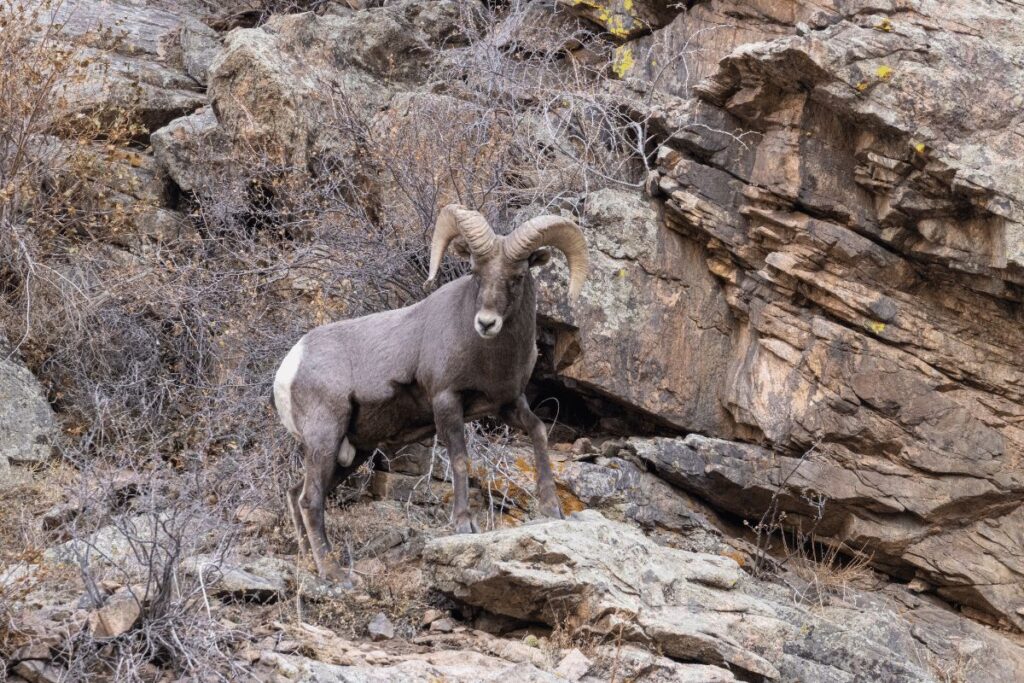
Another animal found in the park is the coyote, which is a common predator in the area.
Coyotes have adapted to the harsh desert environment by being able to eat a wide range of prey, including small mammals, insects, and even cacti. Visitors may hear the distinctive howl of coyotes in the evenings, especially in the quieter parts of the park.
Other notable animals found in Death Valley National Park include the kit fox, black-tailed jackrabbit, kangaroo rat, and several species of snakes and lizards. The park is also home to a number of bird species, including the common raven, red-tailed hawk, and various species of owls.
It is important for visitors to be aware of the wildlife in the park and to take precautions to ensure their safety. This includes not approaching or feeding wildlife, as well as properly storing food and garbage to avoid attracting animals to campgrounds or other areas where people are present.
The wildlife in Death Valley National Park is a unique and fascinating aspect of the park’s ecosystem, and visitors should take the time to observe and appreciate these animals from a safe distance.
Things to do in Death Valley
Here are some of the top things to do in Death Valley National Park:
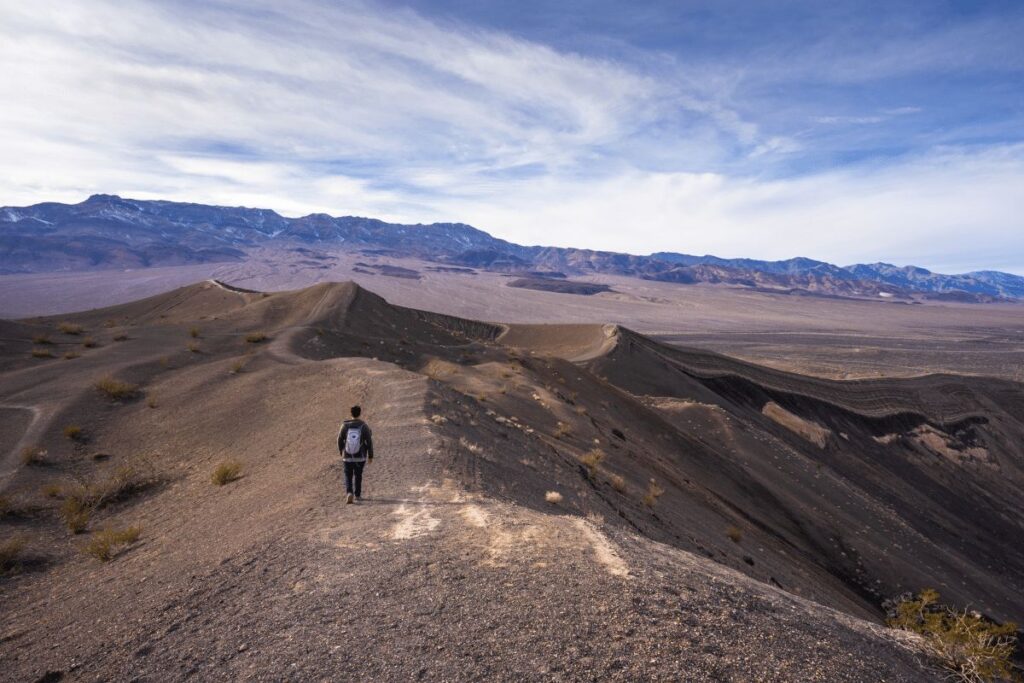
- Hiking: Death Valley is home to over 1000 miles of hiking trails, ranging from short and easy to long and strenuous. Some popular hikes include the Mesquite Flat Sand Dunes, Zabriskie Point, and the Golden Canyon.
- Camping: Camping is a fantastic way to immerse yourself in the beauty of Death Valley. The park has nine campgrounds, each offering a unique experience. Whether you’re looking for a primitive, backcountry camping experience or a fully equipped RV campground, Death Valley has something for everyone.
- Stargazing: Death Valley is known for its breathtaking night sky views, and stargazing is a must-do activity. The park has several designated stargazing areas, including Harmony Borax Works and the Mesquite Flat Sand Dunes. Don’t forget to bring a telescope or binoculars for an even more immersive experience.
- Visit Badwater Basin: Located 282 feet below sea level, Badwater Basin is the lowest point in North America. This vast salt flat is an otherworldly sight, and you can even walk out onto the salt flats for a unique perspective.
- Check out Artist’s Palette: This colorful hillside is a popular spot for photography and offers a stunning view of the park’s geologic history.
- Explore the ghost towns: Death Valley has a rich history, including several abandoned ghost towns. Rhyolite and Skidoo are two of the most well-known ghost towns in the park and are a fascinating look into the area’s past.
- Go off-roading: Death Valley is a popular spot for off-roading enthusiasts. There are several backcountry roads and trails that offer thrilling experiences, including Titus Canyon and the Racetrack.
- Visit Scotty’s Castle: This unique mansion was built in the 1920s and offers a glimpse into the park’s history. Guided tours are available, and the surrounding gardens are a stunning place to relax and enjoy the scenery.
- Visit Ubehebe Crater: This massive crater was formed by a volcanic explosion thousands of years ago and is a unique sight to see. You can hike around the rim for fantastic views or take the steep trail down to the bottom of the crater.
Conclusion
Death Valley National Park is a unique and diverse destination that offers a wide variety of camping options, opportunities to observe fascinating wildlife, and exciting things to do. With its rugged terrain, sweeping vistas, and vast wilderness areas, it’s easy to see why this park draws visitors from around the world.
Whether you’re seeking an adrenaline-pumping adventure or a peaceful escape from the hustle and bustle of everyday life, Death Valley National Park has something to offer. From hiking and rock climbing to bird watching and stargazing, there are countless ways to experience the natural beauty of this amazing park.
When it comes to camping, visitors can choose from a range of options that suit their needs and preferences. Whether you’re looking for a developed campground with all the amenities or a backcountry site that offers solitude and seclusion, there’s a spot for you.
And of course, the wildlife of Death Valley National Park is not to be missed. From bighorn sheep and coyotes to snakes and lizards, there is a whole world of creatures to discover and observe. Whether you’re a seasoned wildlife enthusiast or just a curious traveler, the park’s diverse fauna is sure to impress.
Overall, Death Valley National Park is a must-visit destination for anyone who loves nature, adventure, and outdoor exploration. So whether you’re planning a family vacation, a solo road trip, or a romantic getaway, be sure to add this incredible park to your itinerary.

